Birth of Modern Football DVD
September 25th, 2006
The large number of deaths and even larger number of serious injuries of college football players in 1905 prompted president Theodore Roosevelt to threaten to ban the game unless it was cleaned up. A new rules committee was formed that issued new rules for the 1906 season. These rules created the modern game.
A 10-minute documentary commemorating the 100th anniversary of the birth of modern American football and the single-wing has just been produced. Carlisle played Villanova at 3:00 p.m. Wednesday, September 26, 1906 in what was called “the first important game to be played under the new rules” on Indian Field at Carlisle Barracks. This was also the game in which the single-wing was unleashed.
Cost for the DVD is $9.95 plus $2 shipping and handling (PA residents add 6% for sales tax - even on the shipping).
Order through www.TuxedoPress.LoneStarDietz.com or send a check or credit card information to:
Tuxedo Press
546 E Springville Rd
Carlisle, PA 17015
717-258-9733
Football Offense of 1939 in High Schools-Part 3
September 11th, 2006
Special thanks to Jim Barg for the materials and Guy Savoie for the text conversion
Athletic Journal — 1939
Kansas
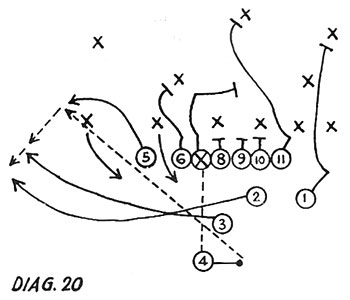
The play shown in Diagram 20 was used successfully last year and is being used with equal success again this year. Five goes out to the left; 6 blocks the weak-side line-backer; 8, 9 and 10 take the defensive guards; 11 blocks the defensive left tackle out and goes for the safety. The center takes the left defensive backer-up. One blocks the defensive left end and goes down for the left halfback. Four cross-steps to his right and feints a run to the right. He steps with his right, pivots and passes in the same motion to the left end 5 who has gone forward two steps and oxd three steps, has turned and is waiting for the pass. After catching the pass, 5 uses a basketball push-pass to 3 sweeping wide around the end. Two swings wider for a possible second lateral. This play works well against a 7-1-2-1 defense and in a passing situation where the backs are a little farther back.
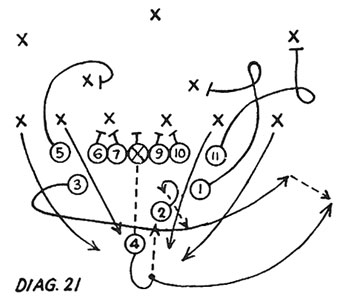
The play shown in Diagram 21 was first used by a Kansas coach to worry the tackles and ends who rushed the passer. It has developed into a good ground gaining play and strengthened the team’s other pass plays. Five circles around over the defensive center, stops and watches the pass and gets into position to block him as the pass is made. Eleven goes down to the defensive left halfback and out. He also watches the pass and gets into position to time his block on the half. One circles the end and “lays” for the defensive left line-backer. Two makes a weak attempt to block the defensive left tackle, pivots back behind the line and waits for the pass. Three starts after the defensive right end and lets him go by, turns and watches the forward pass, then cuts behind 2 Tor the lateral. The passer 4 fades back to a position about twelve yards back of the scrimmage line and looks toward the defensive right halfback. He-telegraphs the pass by holding it high near his ear and waits until the tackles and ends are upon him, then throws an overhand forward pass to 2 and at the same time starts wide around his right end for the second lateral. The five center men are responsible for the two guards. Sometimes the linemen let the guards through and 2 carries the ball through the center.
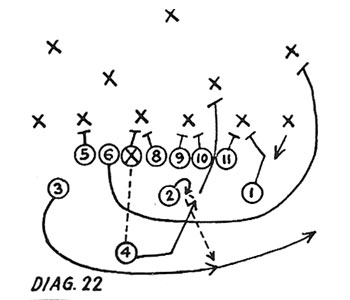
The play shown in Diagram 22 has been used by a Kansas coach within the 15-yard line. The strength of this play lies in the fact that most coaches are smashing their ends against a double wing-back formation. Five blocks the defensive right tackle. The center and 8 block the defensive right guard; 9 and 10 the defensive left guard; 11 and 1 the defensive left tackle. Two pivots to the right outwards and turns his back to the line of scrimmage, squats low and waits for the ball with his arms across his body, his left elbow high. Four takes two steps to the right, cuts into the line, running low, and as he brushes 2, hands him the ball- Two tosses a wide lateral to 3 who runs for the corner of the field.
Kentucky
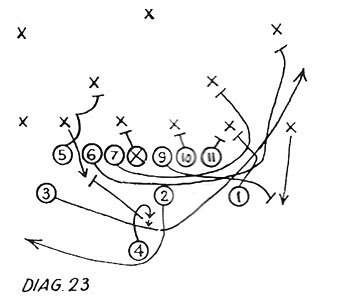
In Diagram 23, a double wing-back play is shown. The ball is snapped to 4 who steps forward and fakes to give it to 2 and then gives it to the wing-back 3 who carries it between the defensive left tackle and end. Four completes the spin into the line; 5 blocks the defensive right linebacker; the center blocks the defensive right guard; 10 blocks the defensive left guard and 11 and 1 block the defensive left tackle in. The right guard 9 blocks the defensive left end out; 6 and 7 lead the ball-carrier through the hole. Two must do a good job of faking; 3 must be fast, 1 a good blocker and 4 a good ball-handler and faker.
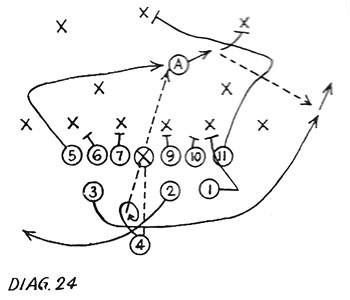
In Diagram 24, the backfield functions the same as in the preceding play. Four steps toward 2 with his right foot, does a half spin as if to give the ball to him, grips the ball and passes it to 5 who times himself to be at the assigned spot A at the right time. Two fakes to carry the ball.
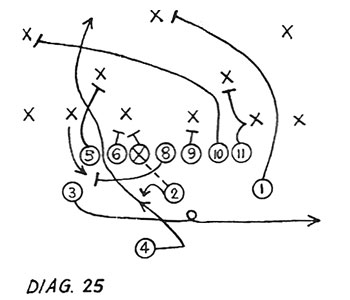
The play shown in Diagram 25 is designed to succeed against over-anxious tackles. Five blocks the right backer-up; 6 and the center take the defensive right guard; 9 the defensive left guard; 10 blocks the defensive right halfback and 11 the left backer-up. One goes down to block the safety. Eight mousetraps the defensive right tackle. Four takes a step to the right to allow 3 to sweep by. He then drives into the line after getting the ball from 2 who faked to give it to 3, going outside the defensive right guard.
Louisiana
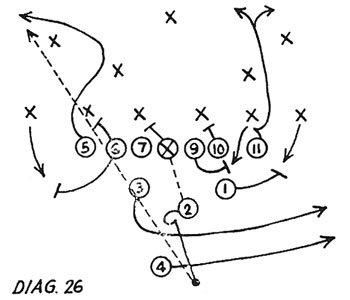
The favorite scoring play of a Louisiana school is shown in Diagram 26. The ball is passed to 2 who spins, faking to 3, and then tosses the ball back to 4, giving the ends time to get down beyond the defensive halfbacks. Five fakes to the right, then cuts wide to the left. Eleven shoulder-blocks the defensive left tackle and drives down field with optional cut as shown in the diagram.
Maine

Diagram 27 — The team that uses the play diagrammed in 27 comes out of a deep punt formation with ends split five or six yards. Then it shifts to a single wing unbalanced to the right. Five brushes the defensive right tackle and takes the halfback; 6 blocks the defensive right guard. The center helps 6 on the guard, then takes the weak-side line-backer; 9 blocks the defensive left guard; 10 and 1 block the tackle; 11 blocks the defensive left end in; 2 takes the left backer-up; 8 goes around and down for the safety; 3 blocks the defensive left halfback. The ball is passed to 4 who sweeps around the defensive left end.

A shuttle pass is shown in Diagram 28. Six blocks the weak-side tackle; the center takes the guard; 9 blocks the defensive right backer-up; 10 blocks the strong-side guard; 11 and 1 block the strong-side tackle in; 8 takes the left backer-up; 2 blocks the safety; 3 blocks the defensive left halfback; the defensive left end is allowed to come in to rush the passer. The ball is passed to 4 who fakes a forward pass and throws an underhand shuttle pass to 5 who has come across.
Massachusetts
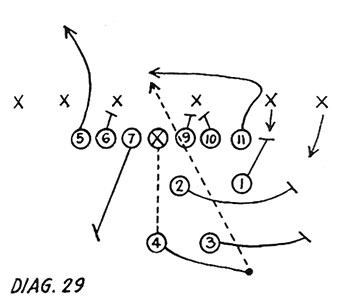
In Diagram 29, 5 goes down, 6 blocks the defensive right guard, 7 drops back; 9 and 10 block the defensive left guard; 11 cuts down field and goes to the left, back of center; 1 blocks the defensive left tackle. The ball is passed to 4 who goes to the right and makes a short bullet pass over center to 11.
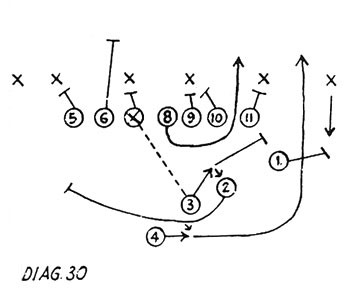
Diagram 30 shows a double reverse. The ball is passed to 3 who takes two steps to the right and lateral passes to 2 who starts to the left, passing the ball to 4 who cuts inside end. The two guards go down field to block the line-backers; 5 blocks the weak-side tackle; the center takes the weak-side guard; 9 and 10 take the strong-side guard; 11 blocks the tackle and 1 blocks the defensive left end.
Snap & Go!
Adam
adam_wesoloski at yahoo.com